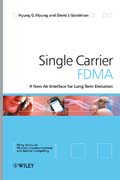
This book provides a technical overview of Single Carrier FDMA (SC-FDMA). SC-FDMA is currently a working assumption for the uplink radio air interface in the 3GPP Long Term Evolution (long term evolution). The book places SC-FDMA in the wider context of wireless communications technology and will provide readers with an in-depth overview and tutorial on SC-FDMA technologies over ten chapters. Features link level simulation of an SC-FDMA System using Matlab. INDICE: Preface 1 Introduction 1.1 Generations 1.2 Standards 1.3 Cellular Standards Organizations 3GPP and 3GPP2 1.4 IEEE Standards 1.5 Advanced Mobile Wireless Systems Based on FDMA 1.6 Figures of Merit 1.7 Frequency Division Technology in Broadband Wireless Systems References 2 Channel Characteristics andFrequency Multiplexing 2.1 Introduction 2.2 Radio Channel Characteristics 2.3Orthogonal Frequency Division Multiplexing 2.4 Single Carrier Modulation withFrequency Domain Equalization 2.5 Summary References 3 Single Carrier FDMA 3.1 Introduction 3.2 SC-FDMA Signal Processing 3.3 Subcarrier Mapping 3.4 Time Domain Representation of SC-FDMA Signals 3.5 SC-FDMA and Orthogonal Frequency Division Multiple Access 3.6SC-FDMA and CDMA with Frequency Domain Equalization3.7Single Carrier Code-Frequency Division Multiple Access (SC-CFDMA) 3.8 Summary References 4SC-FDMA in 3GPP Long Term Evolution 4.1 Introduction 4.2 Protocol Layers and Channels 4.3 Uplink Time and Frequency Structure 4.4 Basic Uplink Physical Channel Processing 4.5 Reference (Pilot) Signal Structure 4.6 Summary References Appendix - List of 3GPP LTE Standards 5 Channel Dependent Scheduling 5.1 Introduction 5.2 S-FDMA Performance Measures 5.3 Scheduling Algorithms 5.4 Channel Models Used in Scheduling Studies 5.5 Channel-Dependent Scheduling Simulation Studies 5.6 Summary References 6 MIMO SC-FDMA 6.1 Introduction 6.2 Spatial Diversity and Spatial Multiplexing in MIMO Systems 6.3 MIMO Channel 6.4 SC-FDMA Transmit Eigen-Beamforming with Unitary Precoding 6.5 SC-FDMA Spatial Diversity 6.6 Summary References 7 Peak Power Characteristics of an SC-FDMA Signal 7.1 Introduction 7.2 Peak Power Characteristics of a Single CarrierSignal 7.3 PAPR of Single Antenna Transmission Signals 7.4 PAPR of Multiple Antenna Transmission Signals 7.5 Peak Power Reduction by Symbol Amplitude Clipping 7.6 Summary References 8 Simulation of an SC-FDMA System Using Matlab 8.1 Introduction 8.2 Link Level Simulation of SC/FDE 8.3 Link Level Simulation of SC-FDMA 8.4 Peak-to-Average Power Ratio Simulation of SC-FDMA 8.5 Summary References Appendix - Simulation Codes Appendix A - Derivation of Time Domain Symbols of Localized FDMA and Distributed FDMA A.1 Time Domain Symbols of LFDMA A.2 Time Domain Symbols of DFDMA Appendix B - Derivations of the Upper Bounds inChapter 7 B.1 Derivation of Equations (9) and (10) in Chapter 7 B.2 Derivations of Equations (13) and (14) in Chapter 7 Appendix C - Deciphering the 3GPP LTE Specifications Appendix D - Abbreviations Index
- ISBN: 978-0-470-72449-1
- Editorial: John Wiley & Sons
- Encuadernacion: Cartoné
- Páginas: 192
- Fecha Publicación: 07/11/2008
- Nº Volúmenes: 1
- Idioma: Inglés
